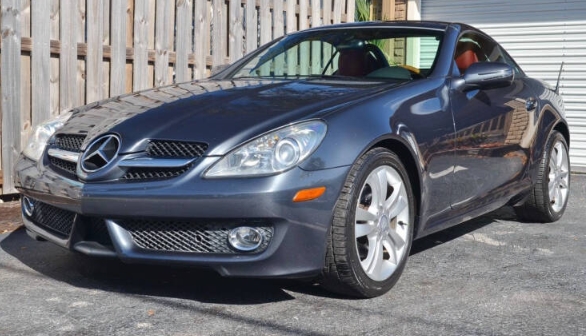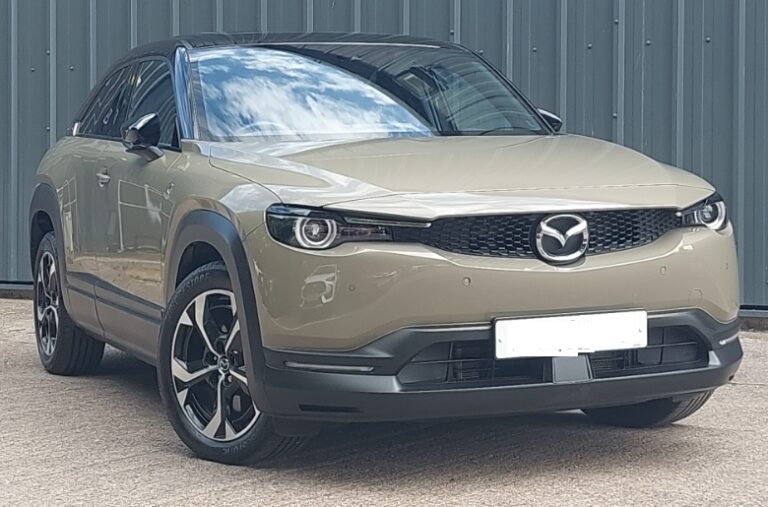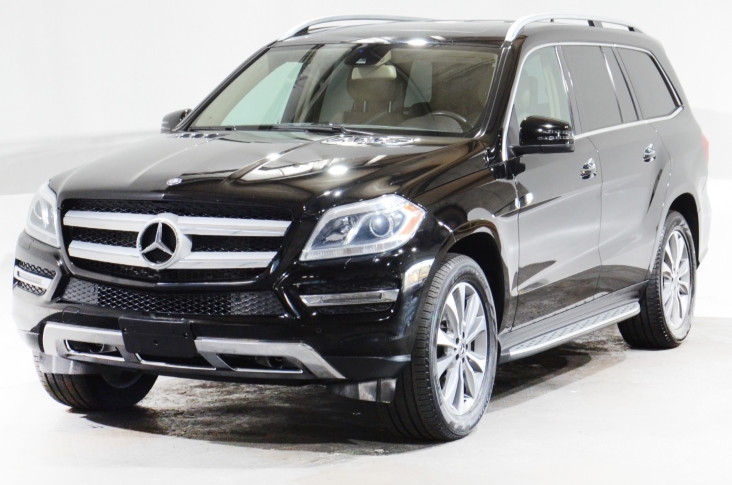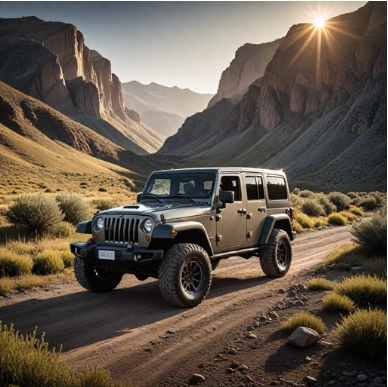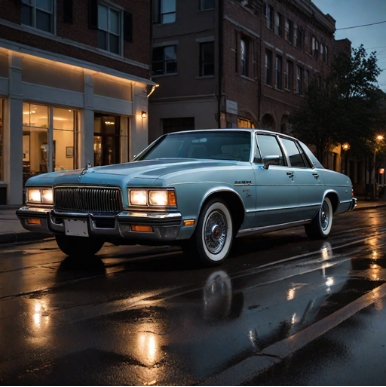The Chameleon of the Open Road: The Evolution of the Mercedes-Benz SLK-Class
In the grand tapestry of automotive history, few cars have so perfectly captured a moment or so cleverly solved a long-standing problem as the Mercedes-Benz SLK-Class. It wasn’t the fastest, nor the most luxurious, but it was revolutionary. It was a car born from a single, brilliant idea: a roadster that could transform, at the touch of a button, into a secure, all-weather coupe. This was the story of the Vario-Roof, and the car that carried it from a novelty to an industry standard. Over three generations and a name change, the SLK evolved from a stylish trendsetter into a mature and formidable sports car, leaving an indelible mark on the concept of open-top motoring.
The Pioneer: R170 (1996-2004)
The mid-1990s witnessed a renaissance for the two-seat roadster. Mazda’s MX-5 had reminded the world of the simple joy of top-down driving, and premium brands were taking notice. BMW had its Z3, Porsche its Boxster. Mercedes-Benz, however, chose a different path. Unveiled as a concept in 1994 and launched in 1996, the first-generation SLK (R170) introduced a feature that would define it for its entire existence: the Vario-Roof.
This electro-hydraulic folding metal hardtop was a piece of engineering theatre. In just 25 seconds, five hydraulic cylinders would gracefully lift the trunk lid backward, fold the two-piece steel roof into a compact sandwich, and swallow it whole, leaving a sleek, open-topped roadster. It offered the security, sound insulation, and weather protection of a coupe with the classic appeal of a convertible. The name itself was a mission statement: Sportlich (Sporty), Leicht (Light), and Kurz (Short).
The initial engine lineup was modest, focusing on accessibility and style over raw power.
- SLK 200 (1996-2000): Primarily for European and other markets, this model used a naturally aspirated 2.0L inline-four engine producing 134 horsepower.
- SLK 200 Kompressor (1996-2000): For markets like Italy with tax penalties on engines over 2.0 liters, this supercharged version of the same engine delivered a much more robust 189 horsepower.
- SLK 230 Kompressor (1996-2000): The flagship and most popular model at launch, its 2.3L supercharged inline-four produced 193 horsepower, giving the lightweight car spirited performance.
The R170’s styling was soft and organic, with classic long-hood, short-deck proportions and distinctive twin “power domes” on the hood, a nod to the legendary 300 SL. The interior was a playful departure for the typically staid Mercedes, featuring optional vibrant two-tone leather schemes (like red and black) and a choice of wood or a sporty carbon-fiber-effect trim.
In 2000, the R170 received a comprehensive facelift. The styling was sharpened with redesigned front and rear bumpers and body-colored side skirts. Turn signals were integrated into the wing mirrors, a feature that would become a Mercedes signature. More importantly, the powertrain lineup was significantly expanded and upgraded.
- SLK 200 Kompressor (2000-2004): A new supercharged 2.0L engine replaced both previous 2.0L versions, now producing a more efficient 161 horsepower.
- SLK 230 Kompressor (2000-2004): The 2.3L engine was tweaked and now produced 197 horsepower.
- SLK 320 (2000-2004): For the first time, the SLK received six-cylinder power. A smooth 3.2L V6 with 215 horsepower was added to the range, offering a more refined and powerful grand touring experience. A six-speed manual transmission became standard on most models.
The facelift also brought the SLK its first AMG model. The SLK 32 AMG (2001-2004) was a compact powerhouse. Its 3.2L V6 was fitted with a helical supercharger, rocketing output to a staggering 349 horsepower and 332 lb-ft of torque. Paired exclusively with a reinforced five-speed automatic transmission, it could sprint from 0-60 mph in under five seconds, turning the stylish roadster into a genuine muscle car that could challenge a Porsche Boxster S.
.
THIS could come in handy for your auto garage (and everywhere else!):

.
The Athlete: R171 (2004-2011)
If the R170 was the stylish innovator, the second-generation R171 was the focused athlete. Unveiled at the 2004 Geneva Motor Show, its design was a dramatic departure. The soft curves were replaced by sharp, aggressive lines heavily inspired by the Mercedes-McLaren SLR supercar, most notably in its distinctive, Formula 1-style pointed nose. It looked longer, lower, and significantly more purposeful.
The engineering advancements were just as profound. The Vario-Roof was faster, operating in 22 seconds and taking up less trunk space when stowed. But the R171’s killer feature was another comfort innovation: AIRSCARF. This system integrated vents into the headrests that blew warm air around the occupants’ necks, creating a “virtual scarf” that made top-down driving comfortable even on chilly days. It was a brilliant addition that extended the convertible season and was soon copied across the industry.
The R171 chassis was stiffer, and the steering was far more direct, addressing criticisms of the R170’s somewhat leisurely handling. The engine lineup moved decisively upmarket, dropping the four-cylinders from the North American market entirely for a time.
- SLK 200 Kompressor (2004-2008): The entry-level engine continued in Europe, an 1.8L supercharged four-cylinder making 161 horsepower.
- SLK 280 (2005-2009): This model featured a new-generation 3.0L V6 with 228 horsepower, providing a smooth and responsive entry into six-cylinder performance.
- SLK 350 (2004-2008): The performance sweet spot for many, this featured a potent 3.5L V6 with 268 horsepower and was available with an optional 7G-Tronic seven-speed automatic transmission.
The pinnacle of the R171 range was the astonishing SLK 55 AMG (2004-2010). In a move that shocked the sports car world, AMG engineers shoehorned a massive, naturally aspirated 5.4L V8 engine into the SLK’s compact engine bay. It produced a thunderous 355 horsepower and 376 lb-ft of torque, all accompanied by a guttural, muscle-car soundtrack. It was an unapologetically brash and exhilarating machine, a “hot rod” in a tailored suit. An even more exclusive, track-focused SLK 55 AMG Black Series (2006-2008) was produced in limited numbers, featuring a fixed carbon-fiber roof, wider track, adjustable suspension, and a power bump to 400 horsepower.
A 2008 facelift brought subtle but effective changes. The front bumper was reshaped for a more aggressive look, and the interior received a new instrument cluster and infotainment system. The engines were also revised for more power and better efficiency.
- SLK 200 Kompressor was updated to 181 horsepower.
- SLK 280 was re-badged as the SLK 300 (2009-2011) with its power output remaining at 228 hp.
- SLK 350 received a heavily revised engine with a higher redline and a jump in power to 300 horsepower, transforming it into a much sportier drive.
The Sophisticate: R172 (2011-2020) and the SLC Name Change
The third and final generation, the R172, arrived in 2011 as a more mature, refined, and technologically advanced machine. The design language an “F1 nose” for a more upright, “masculine” front grille and headlights reminiscent of the flagship SLS AMG “Gullwing.” The overall impression was one of substance and luxury, shifting the car’s image slightly from a pure sports car to a premium compact grand tourer.
The interior took a significant leap forward in quality and design, mirroring the aesthetics of the SLS AMG with its circular air vents and high-quality materials. The R172’s headline innovation was Magic Sky Control, an optional panoramic glass Vario-Roof that could change its tint from dark to transparent at the press of a button, allowing occupants to enjoy an open-air feeling even with the roof closed.
The engine lineup embraced the industry trend of downsizing and turbocharging for greater efficiency.
- SLK 200 BlueEFFICIENCY (2011-2015): A turbocharged 1.8L four-cylinder with 181 horsepower.
- SLK 250 BlueEFFICIENCY (2011-2015): The same 1.8L turbo engine, tuned to produce 201 horsepower.
- SLK 350 BlueEFFICIENCY (2011-2015): A direct-injected 3.5L V6 was the top non-AMG model, producing a healthy 302 horsepower.
- SLK 250 CDI BlueEFFICIENCY (2012-2015): In a first for the SLK, a diesel model was offered in Europe, using a twin-turbo 2.1L four-cylinder that offered impressive torque and fuel economy.
The AMG model returned as the SLK 55 AMG (2012-2015), but with a clever twist. It still featured a naturally aspirated V8—a new 5.5L unit—but now with AMG Cylinder Management. This system could shut down four of the eight cylinders under light load to dramatically improve fuel efficiency, making it the most economical V8 in its class. Power was a formidable 416 horsepower.
The Transition to SLC (2016-2020)
In 2016, as part of a company-wide restructuring of its naming conventions, Mercedes-Benz gave the SLK a facelift and a new name: the SLC-Class. The “SL” continued to denote its roadster heritage, while the “C” now signified its position in the lineup as being aligned with the C-Class. The facelift included a new “diamond” grille, revised bumpers, and an updated cabin with a larger infotainment screen. The Vario-Roof could now be operated at speeds up to 25 mph.
The model lineup was also overhauled to reflect the new nomenclature and engine strategy.
- SLC 180 (2016-2020): A new entry-level model for some markets, with a 1.6L turbo-four producing 154 horsepower.
- SLC 200 (2016-2020): Used a 2.0L turbo-four with 181 horsepower.
- SLC 300 (2016-2020): Replaced the SLK 250, featuring a 2.0L turbo-four with a punchy 241 horsepower.
- SLC 250d (2016-2017): The diesel variant was carried over briefly.
The most significant change came to the AMG model. The naturally aspirated V8 was retired, a victim of tightening emissions standards. It was replaced by the Mercedes-AMG SLC 43 (2016-2020). This model used a 3.0L twin-turbocharged V6 engine producing 362 horsepower (later increased to 385 hp in 2019). While it lacked the V8’s iconic roar and raw character, the SLC 43 was a supremely capable and fast machine, with its lighter engine improving handling balance.
In 2019, Mercedes announced the SLC Final Edition, a special model with unique paint colors and interior trims that paid homage to the original R170. Production of the SLC ceased in 2020, bringing the 24-year story of the compact Mercedes roadster to a close.
From the clever R170 that democratized the retractable hardtop, to the muscular R171 that introduced AIRSCARF and a V8, to the sophisticated R172/SLC with its Magic Sky, the SLK-Class consistently punched above its weight. It was a chameleon, capable of being a stylish city cruiser, a comfortable tourer, or a ferocious performance car. While it may no longer grace showrooms, its legacy is assured—etched in the memory of every driver who enjoyed the magic of an open sky one moment and the serenity of a coupe the next, all with the simple press of a button.
